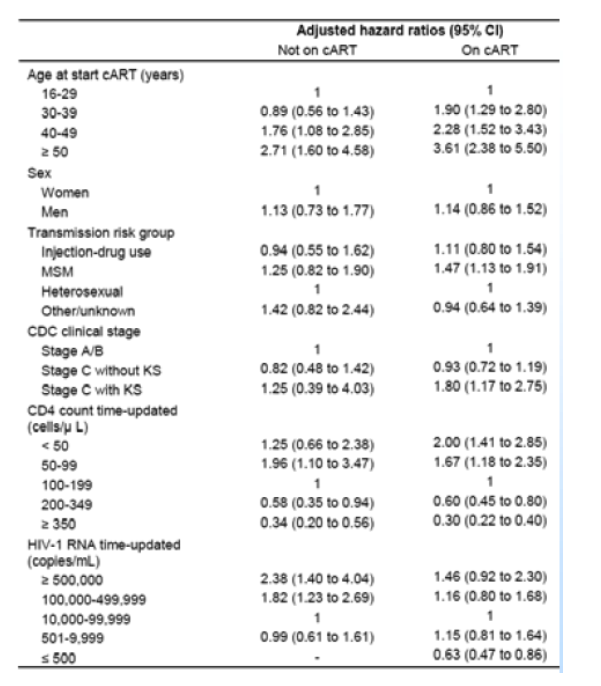 |
 |
 |
| |
Influence of ART on Incidence and Prognosis of HIV-1-associated Non-Hodgkin's Lymphoma: European Multi-Cohort Study, CD4 Predicts Non-Hodgkin's Lymphoma
|
| |
| |
Reported by Jules Levin CROI 2009 Montreal Feb 8-12
Suppression of HIV-1 replication and increases in CD4 counts were protective. Similar associations were observed in patients not on cART, see Table 1 below. More advanced immunodeficiency (CD4 count) is the dominant prognostic factor for mortality in patients with HIV-related NHL.
J Bohlius, Matthias Egger*, and Collaboration of Observational HIV Epidemiological Res Europe (COHERE) Study Group
Inst of Social and Preventive Med, Univ of Bern, Switzerland
Background: We studied the incidence, risk factors, and survival of non-Hodgkin's lymphoma in HIV-infected patients in the era of combination ART, using the data from a large prospective European multi-cohort study, the Collaboration of Observational HIV Epidemiological Research Europe (COHERE),
Methods: We analyzed data of HIV-infected patients (aged >16 years) who were ART- naive at inclusion and started ART after January 1, 1998. ART was defined as a regimen of at least 3 ARV drugs. Patients developing non-Hodgkin's lymphoma before and while receiving ART were analyzed separately; primary brain lymphoma and systemic non-Hodgkin's lymphoma patients were included. Incidence rates were calculated and risk factors identified using crude and adjusted Weibull random-effects models. Time varying co-variates were used to explore the effects of CD4 cell counts and plasma HIV-1 RNA load over time.. Survival was estimated using Kaplan-Meier life-table probabilities, with 95% confidence intervals (95%CI).
Results: We evaluated 56,305 patients from 22 cohort studies across Europe with 212,042 person-years at risk. The incidence for non-Hodgkin's lymphoma (systemic non-Hodgkin's lymphoma and primary brain lymphoma) in patients not on ART was 519 (95% CI 448-602) per 100,000 person-years compared to 229 (95%CI 208 to 252) per 100,000 person-years in those on ART. In multivariable analyses risk factors for non-Hodgkin's lymphoma were older age and low CD4 cell count nadirs in patients not on ART. When included as time up-dated variables, high plasma HIV-1 RNA loads and low CD4 cell counts emerged as independent risk factors. In multivariable analyses risk factors included low CD4 cell count nadirs, older age, men who have sex with men (MSM), and a history of Kaposi's sarcoma for patients on ART. Time up-dated HIV-1 RNA plasma concentration and CD4 cell count were also associated with developing non-Hodgkin's lymphoma while on ART. -In the survival analysis, 847 non-Hodgkin's lymphoma patients were included. Of those, 364 (43%) were ART naive at non-Hodgkin's lymphoma diagnosis. After 1 year 66% (95%CI 63% to 70%) of systemic non-Hodgkin's lymphoma and 54% (95%CI 43% to 65%) of primary brain lymphoma patients were alive. In multivariable analysis risk factors for death were diagnosis of primary brain lymphoma, low CD4 cell count nadir and history of injection drug use.
Conclusions: The risk of HIV-related non-Hodgkin's lymphoma is about halved in patients on ART, and this reduction was mediated by suppression of HIV-1 replication and immune recovery. Two-thirds of patients diagnosed with HIV-1-related non-Hodgkin's lymphoma other than primary brain lymphoma survive for longer than 1 year after diagnosis. Survival is poorer in patients diagnosed with primary brain lymphoma.
Table 1: Risk factors for developing NHL: _hazard ratios from multivariable models including time-updated _CD4 cell counts and HIV-1 viral loads

Survival
847 NHL patients (systemic NHL and PBL) were included in the survival analysis. Of those, 364 patients (43%) NHL was diagnosed while not on cART. Among patients diagnosed with NHL while on cART, 115 (14%) had received cART for less than 90 days and 368 (43%) for more than 90 days. Survival at one year was 66% (95% CI 63-70%) for systemic NHL (n=763) and 54% (95% CI 43%-65%) for PBL (n=84). Patients developing systemic NHL on cART had an increased risk of death compared to patients who were cART naive at diagnosis, see Figure 1 below. In multi-variable analysis including both patients with systemic NHL and PBL, risk factors for death were history of cART treatment, diagnosis of PBL, low CD4 cell count nadir and history of injection drug use. Hazard ratios were closely similar in analyses excluding PBL patients.
Limitations Main limitations are as follows:
- Incomplete data on CD4 counts
- no data on NL related information, including histology, tumor load, tumor staging, prpgnostic markers, and chemotherapy received.
- potential survivor bias: patients who developed NHL while not receiving cART and died before starting cART were not included in the data sets analyzed, tis may have led to an overestimation of survival in cART naive patients.
Conclusion
The association with Kaposi Sarcoma suggests a role of HHV-8 in HIV-associated NHL, which needs further investigation. Incidence is substantially reduced in patients on cART. Timely initiation of cART is therefore key to the prevention of NHL in the era of cART. Two thirds of patients diagnosed with HIV-related systemic NHL survive for longer than one year after diagnosis. Survival is poorer in patients diagnosed with PBL. More advanced immunodeficiency is the dominant prognostic factor for mortality in patients with HIV-related NHL.
|
| |
|
 |
 |
|
|